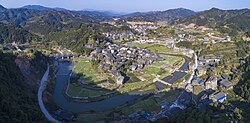world.wikisort.org - China
Sanjiang Dong Autonomous County (simplified Chinese: 三江侗族自治县; traditional Chinese: 三江侗族自治縣; pinyin: Sānjiāng Dòngzú Zìzhìxiàn; Standard Zhuang: Sanhgyangh Dungcuz Swciyen) is under the administration of Liuzhou, Guangxi Zhuang Autonomous Region, China. It is a region traditionally inhabited by the Dong people, bordering the prefecture-level divisions of Qiandongnan (Guizhou) to the north, Huaihua (Hunan) to the northeast and Guilin to the west.
Sanjiang County
三江县 · Sanhgyangh Yen Sankiang | |
|---|---|
County | |
| Sanjiang Dong Autonomous County 三江侗族自治县 Sanhgyangh Dungcuz Swciyen | |
 Aerial panorama of Chengyang, a scenic area in Sanjiang | |
 Sanjiang Location in Guangxi | |
| Coordinates: 25°47′N 109°36′E[1] | |
| Country | People's Republic of China |
| Autonomous region | Guangxi |
| Prefecture-level city | Liuzhou |
| Area | |
| • Total | 2,455 km2 (948 sq mi) |
| Population (2010)[3] | |
| • Total | 297,244 |
| • Density | 120/km2 (310/sq mi) |
| Time zone | UTC+8 (China Standard) |
| Postal code | 5455XX |
It has an area of 2,429 square kilometres (938 sq mi) and a population of 297,244.[4]
Transportation
- China National Highway 209
- Reach by bus from Longsheng Rice Terrace about 1.5 hours, Guilin 4.5 hours
- Sanjiang County Railway Station, about 10 kilometres (6.2 mi) from the main square and "Bird's Nest" bullfighting arena.
- Sanjiang South Railway Station, also about 10 kilometres (6.2 mi) south from the main square. The station mainly serves the Guiyang-Guangzhou high-speed railway that pass through the area.
Tourism
20 kilometres (12 mi) north of Sanjiang, toward Hunan province, lies the area of Dong people, Chengyang (程阳), which is a popular destination for backpacker tourism. The area comprises eight traditional Dong minority villages. The houses are all made of wood. Inside the villages you will find traditional drum towers, which were used to announce important things or simply to perform plays to entertain the villagers. Crossing the river is the best preserved Wind and Rain Bridge (程阳风雨桥, chéng yáng fēng yǔ qiáo) which has five parts. The bridge dates to 1912 and is for many people the main reason to visit the village.
North of Chengyang lies the tiny village of Linxia which is interesting because of the local market, but there are no places to stay in Linxia.
Climate
| Climate data for Sanjiang (1981−2010) | |||||||||||||
|---|---|---|---|---|---|---|---|---|---|---|---|---|---|
| Month | Jan | Feb | Mar | Apr | May | Jun | Jul | Aug | Sep | Oct | Nov | Dec | Year |
| Record high °C (°F) | 26.6 (79.9) |
30.4 (86.7) |
33.3 (91.9) |
34.4 (93.9) |
35.4 (95.7) |
37.8 (100.0) |
39.2 (102.6) |
38.7 (101.7) |
39.1 (102.4) |
35.2 (95.4) |
31.5 (88.7) |
27.4 (81.3) |
39.2 (102.6) |
| Average high °C (°F) | 11.3 (52.3) |
13.4 (56.1) |
17.4 (63.3) |
23.6 (74.5) |
27.9 (82.2) |
30.7 (87.3) |
32.8 (91.0) |
33.3 (91.9) |
30.7 (87.3) |
25.2 (77.4) |
20.2 (68.4) |
14.8 (58.6) |
23.4 (74.2) |
| Daily mean °C (°F) | 7.4 (45.3) |
9.4 (48.9) |
13.0 (55.4) |
18.6 (65.5) |
22.7 (72.9) |
25.7 (78.3) |
27.4 (81.3) |
27.2 (81.0) |
24.5 (76.1) |
19.6 (67.3) |
14.5 (58.1) |
9.4 (48.9) |
18.3 (64.9) |
| Average low °C (°F) | 4.8 (40.6) |
6.9 (44.4) |
10.2 (50.4) |
15.3 (59.5) |
19.2 (66.6) |
22.5 (72.5) |
23.9 (75.0) |
23.6 (74.5) |
20.6 (69.1) |
16.1 (61.0) |
11.0 (51.8) |
6.0 (42.8) |
15.0 (59.0) |
| Record low °C (°F) | −3.3 (26.1) |
−2.7 (27.1) |
−0.5 (31.1) |
3.7 (38.7) |
9.3 (48.7) |
13.1 (55.6) |
17.2 (63.0) |
18.9 (66.0) |
13.0 (55.4) |
4.6 (40.3) |
0.8 (33.4) |
−4.3 (24.3) |
−4.3 (24.3) |
| Average precipitation mm (inches) | 53.9 (2.12) |
72.3 (2.85) |
94.5 (3.72) |
146.9 (5.78) |
250.2 (9.85) |
308.1 (12.13) |
249.3 (9.81) |
144.1 (5.67) |
66.5 (2.62) |
70.7 (2.78) |
62.8 (2.47) |
38.3 (1.51) |
1,557.6 (61.31) |
| Average relative humidity (%) | 79 | 80 | 81 | 82 | 83 | 84 | 83 | 82 | 79 | 80 | 79 | 77 | 81 |
| Source: China Meteorological Data Service Center[5] | |||||||||||||
Notable people
- Wu Hongfei, journalist, novelist, and rock singer
See also
References
- Google (2014-07-02). "Sanjiang" (Map). Google Maps. Google. Retrieved 2014-07-02.
- Liuzhou City Land Use Plan (2006–20)/《柳州市土地利用总体规划(2006-2020年)》.(in Chinese) Accessed 8 July 2014.
- 《中国2010年人口普查分县资料》 (in Chinese). 中国统计出版社. December 2012. ISBN 978-7-5037-6659-6.
- (in Chinese) Profile of Sanjiang, official website of Sanjiang County Government
- 中国地面气候标准值月值(1981-2010) (in Simplified Chinese). China Meteorological Data Service Center. Retrieved 7 November 2022.
External links
На других языках
- [en] Sanjiang Dong Autonomous County
[fr] Xian autonome dong de Sanjiang
Le xian autonome dong de Sanjiang (chinois : 三江侗族自治县 ; pinyin : sānjiāng dòngzú zìzhìxiàn) est un district administratif de la région autonome du Guangxi en Chine. Il est placé sous la juridiction de la ville-préfecture de Liuzhou.[ru] Саньцзян-Дунский автономный уезд
Саньцзя́н-Ду́нский автоно́мный уе́зд (кит. упр. 三江侗族自治县, пиньинь Sānjiāng Dòngzú zìzhìxiàn) — автономный уезд городского округа Лючжоу Гуанси-Чжуанского автономного района (КНР).Другой контент может иметь иную лицензию. Перед использованием материалов сайта WikiSort.org внимательно изучите правила лицензирования конкретных элементов наполнения сайта.
WikiSort.org - проект по пересортировке и дополнению контента Википедии